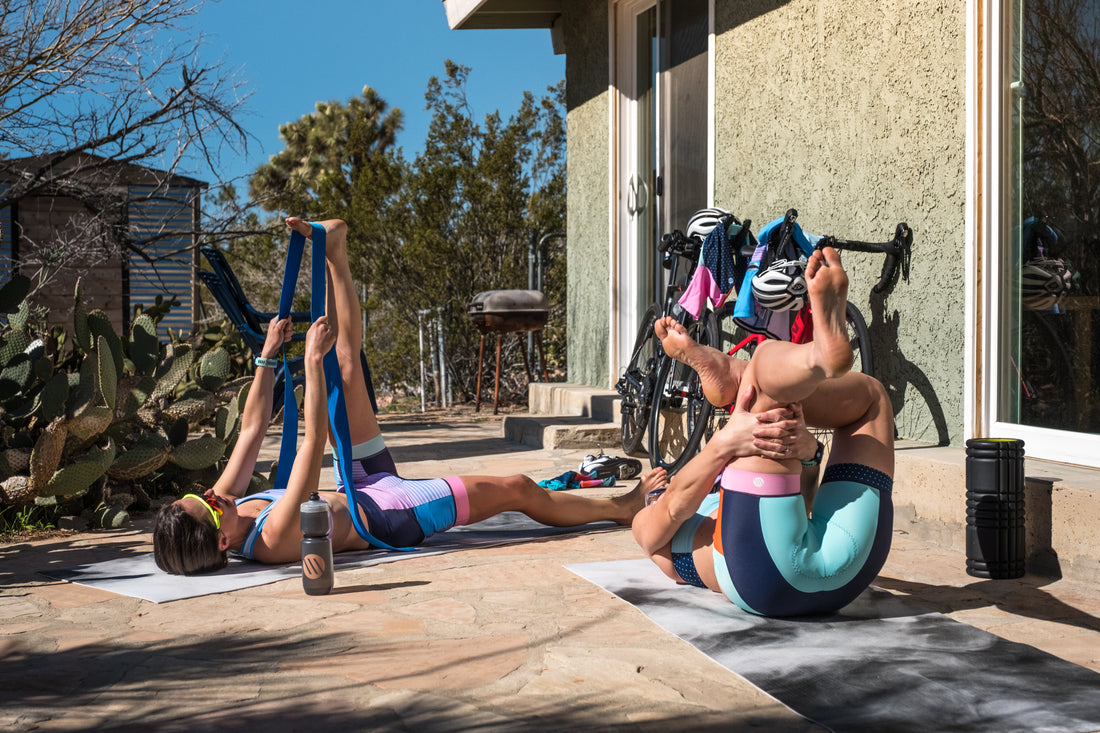4 Perspective Shifts to Help Athletes Avoid Injury & Improve Performance
As a physiotherapist specializing in working with endurance athletes and runners, as well as a Coach and athlete myself, I have seen thousands of athletes navigate the highs and lows of training and racing. While there will always be days where you just can’t find your sweet spot, I have learned a lot over the years about strategies that help athletes thrive.
Whether you have years of experience in triathlon or are just starting to dream of chasing the goals that light you up, here are four shifts in perspective that can help you avoid injury and feel like the strongest, most resilient, healthiest version of yourself!
1. Work hard, rest hard
Fact: If you approached recovery with the same gusto as training, you would almost certainly see a huge improvement in your performance and efficiency.
Training is a constant cycle of destruction, repair and adaptation. You push to the edge of your ability in your workout, then recover to allow repair and adaptation.
So technically, growth and strength don’t come during the workout itself, but during the recovery time in between. If you shift your perspective to embrace that, you’ll likely encounter fewer injuries (not to mention less burnout and fatigue), and a stronger and faster you!
Remember too that stress, whether it’s emotional, mental or physical, will play into your ability to perform and tolerate the demands of training and racing. So if you’re powering through a particularly nutty period at work, juggling something taking an emotional toll or knocking off a high volume training week, remember that as stress increases, so too must your recovery efforts.
If there is one thing that athletes could benefit from the most, it’s a better understanding of the need for intentional recovery. Own it!
2. Stop referring to strength and mobility work as “the little things”!
If I were to offer you a tool proven to have the power to dramatically increase your performance, reduce injury risk and help you thrive in your training, racing and life outside of sport, would you call it “little”? Absolutely not! Send those super powers my way!
I get it, as a person who wears multiple hats, thrives on “busy” and views a run-induced endorphin hit as a lifeline when life is overwhelming, it’s easy to write off other aspects of training as “little”. We prioritize the “real” workouts, tell ourselves we don’t have time, or promise to be better about it next week.
That said, we have so much evidence that tools like mobility work, drills, warm ups and consistent strength training are incredibly valuable for endurance and multisport athletes. So much so that you would be doing yourself an absolute disservice if you were to consistently push those tools aside.
3. While you’re at it, don’t be afraid to load!
For every step that you take while running, your body is up against 2.5-6x your body weight in load. Multiply that by ~1,000 steps per kilometer run, and you can appreciate that the demands of running are significant, not to mention what cycling and swimming bring to the table.
Consider then, whether 3 sets of 10 clamshells is really going to load you in a way that compliments your goals as an athlete. Body weight exercises have their place, but for most female athletes, using those types of exercises alone as a long term strength training plan leaves so much on the table!
A progressive strength training program with load is like giving your body a jet engine. In addition to optimizing your body to be able to withstand the demands of triathlon, it also leads to greater improvements in performance than body weight exercises alone.
Access to equipment can be tough, but don’t let that stop you! A little creativity by filling buckets/bottles, combining lighter weights in a sturdy bag or using household objects can absolutely provide some advantage.
In need of a little inspiration? Here’s a favourite series that is perfect for runners and triathletes!
4. Running is a skill – treat it like one!
If you wanted to work really hard on a tennis goal, would you go to a local school yard, hit the ball against a wall for hours at a time and expect to get really good?
Of course not! You’d pay attention to your technique, work through drills, practice sticking points and consider working with a Coach.
Like any other sport, running is a motor skill. That means that with drills and the right cues, you can dramatically increase your efficiency and decrease your injury risk as you improve your ability to execute the skill well.
At its core, running is all about creating as much force as possible, pushing the ground away as we drive ourselves forward, while using the least amount of energy to do so. Thinking back to the 1,000 steps per kilometer x 2.5-6x your body weight of load guideline, it’s exciting to think of the possibility that a tad more efficiency could bring.
Most triathletes are used to considering technique in the pool, but either ignore it or aren’t sure where to start when it comes to running. Whether you’re looking to reduce injury risk, build performance or both, it is worth your time and effort to build in regular drill work (even the pros do!). If you aren’t sure where to start, consider working with a physio, coach or other movement professional for guidance.
Down for a quick primer on some of the most common errors in run technique? I got you!
So there you have it; four shifts in perspective that could help you be that much stronger as you train and race (eventually!).
Lindsay Scott
MSC.PT, MCISC, FCAMPT
Lindsay Scott is a physiotherapist at The Runner’s Academy in Toronto, where she arms endurance athletes of all levels with the tools and knowledge they need to be strong, healthy, resilient and fearless in the pursuit of their goals. When not working clinically, Lindsay leads courses and mentorship groups to help clinicians and movement professionals grow their skillset working with runners and build a practice that lights them up. New Mom, triathlete, coach, and enthusiast of all things active. Find Lindsay on Instagram @lindsayscottphysio.




